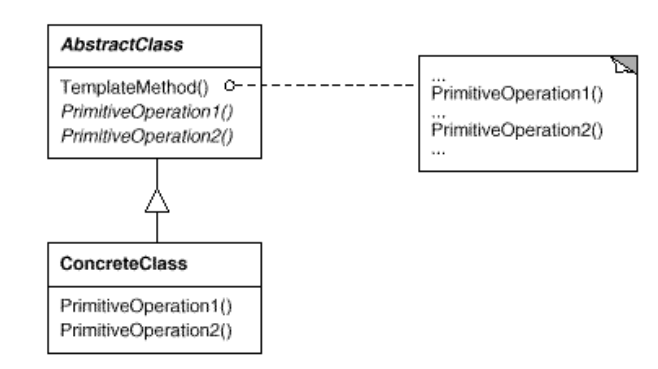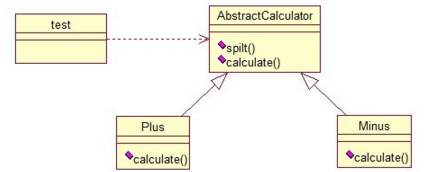22. Template Method
- Intent:
- Define the skeleton of an algorithm in an operation, deferring some steps to subclasses. Template Method lets subclasses redefine certain steps of an algorithm without changing the algorithm’s structure.
- Applicability:
- to implement the invariant parts of an algorithm once and leave it upto subclasses to implement the behavior that can vary.
- when common behavior among subclasses should be factored and localized in a common class to avoid code duplication.
- to control subclasses extensions.
- Structure:

- Participants:
- AbstractClass
- defines abstract primitive operations that concrete subclasses define to implement steps of an algorithm.
- implements a template method defining the skeleton of an algorithm.The template method calls primitive operations as well as operations defined in AbstractClass or those of other objects.
- ConcreteClass
- implements the primitive operations to carry out subclass-specific steps of the algorithm.
- AbstractClass
- Collaborations
- ConcreteClass relies on AbstractClass to implement the invariant steps of the algorithm.
- Consequences:
Template methods are a fundamental technique for code reuse. Template methods lead to an inverted control structure that’s sometimes referred to as “the Hollywood principle,” that is, “Don’tcall us, we’ll call you”
- Related Patterns:
- Factory Methods are often called by template methods. In the Motivation example,the factory method DoCreateDocument is called by the template method OpenDocument.
- Strategy: Template methods use inheritance to vary part of an algorithm. Strategies use delegation to vary the entire algorithm.
- Code Sample: Template Method

public abstract class AbsCalculator {
public final int calculate(String exp,String opt){
int array[] = split(exp,opt);
return calculate(array[0],array[1]);
}
abstract public int calculate(int num1,int num2);
public int[] split(String exp,String opt){
String array[] = exp.split(opt);
int arrayInt[] = new int[2];
arrayInt[0] = Integer.parseInt(array[0]);
arrayInt[1] = Integer.parseInt(array[1]);
return arrayInt;
}
}
public class Plus extends AbsCalculator {
@Override
public int calculate(int num1,int num2) {
return num1 + num2;
}
}
public class StrategyTest {
public static void main(String[] args) {
String exp = "10+2";
AbsCalculator cal = new Plus();
int result = cal.calculate(exp, "\\+");
System.out.println(result);
}
}
